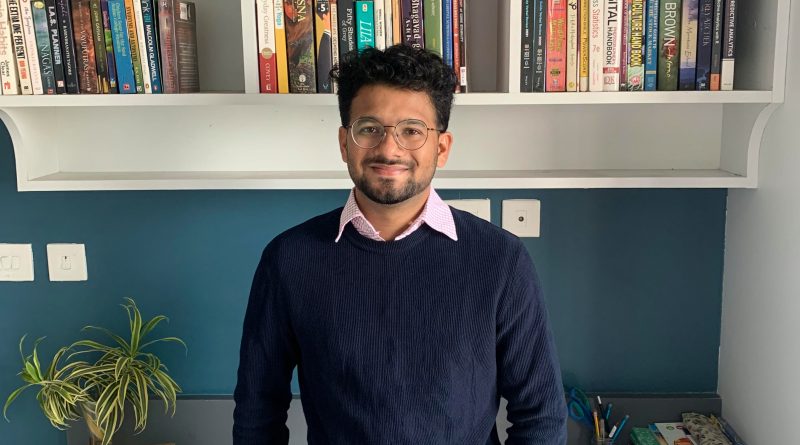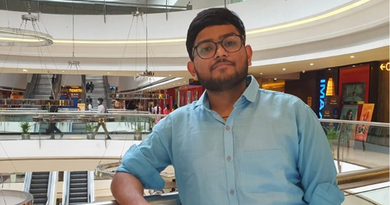Building a career in product design: An interview with Shivani Gaur, the principal product designer at Internshala

About the interviewee: Shivani has an academic background in engineering but a success story in design. She shares insights about product design, her career trajectory, and the skills needed to thrive as a designer.
1. What is product design?
Product design is the process used by designers to meet the user’s needs with the business goals. For example, the business team can give us a goal that 10k users need to sign up through a page. Based on this brief, we design the product in a way that is helpful for the user and meets the objective.
Product designers consistently optimise the user experience by thinking from the basic principles of design. It is an iterative process, and they are constantly working on it.
2. How did you get interested in design?
I was in college when I got to know about innovative competitions like Imagine Cup by Microsoft and Innovation Jockeys by Accenture. My friend used to participate in these competitions. I realised that I could participate too and learn new skills apart from the ones I was learning through my course.
While participating in these competitions, I worked with other team members to design and develop mobile apps, videos, 3D models of products, and website mockups. I remember learning new tools like 3D Blender in two days so that we could meet the deadline. I ended up learning the basics and even prepared a video. Since we had weekly deadlines, I was constantly working on projects. These experiences were thrilling. I had never got this feeling before, and I never enjoyed working until this point. It took me an entire night to learn the basics of Blender, but I didn’t look at the clock even once. At this moment, I realised that design is something I can be good at, in fact, better than coding.
Moreover, I was studying voluntarily for a change! I was going through articles to learn more about design. This took place in 2014 when design was just emerging. At that time, there were hardly any resources or people you could reach out to. So I was really thankful for Google, YouTube, and Quora.
3. What led you to your current job at Internshala? What roles have you held in the past?
While participating in the design competitions in my final year, I also took up a design internship. During this time, I designed a website for an event called TechXplore, and I really enjoyed doing that. After this internship, I started applying to different design jobs and landed two interviews, one of them being at Internshala.
During my interview at Internshala, Sarvesh, the CEO and founder, asked me an interesting question – ‘If there are two jobs, one that belongs to an IT company as a software engineer and another one at a start-up that offers you half of the CTC being offered by the IT company, which one would you choose?’
At this time, I had also been placed at TCS as a software engineer. That job was supposed to be my plan B so that my parents did not have to worry. Without a moment of hesitation, I responded – ‘Of course, I will go with the IT company because they will pay me double the amount.’
He laughed and asked me why I would do that since I had already experimented so much and realised that I liked design. He gave me personal advice and said that I should go with design. However, I was worried that if I chose design, my four years of engineering degree would be a sheer waste. At the same time, I pondered over what Sarvesh had said in the interview – ‘Why would you do something for which you have to look at the clock every time, and why not something that you enjoy every moment of? You stayed up late at night to make things happen.’ That is when I realised design is my calling, and Internshala would be the best place to learn. If I learned this much in an interview, then how much I can learn in the coming years. So I ended up going with Internshala (even though I was not expecting to get selected after being brutally honest in my interview!).
I joined Internshala as a graphic designer. I learned all the basics of design from my first manager, Pratyush who was responsible for managing the entire design process at Internshala. At long last, I had found a design mentor. But my happiness was short-lived because Pratyush switched to a different team in three months. This moment transpired into a major turning point in my career.
I was the only designer at Internshala for six months. Initially, it was overwhelming. I used to struggle with planning and prioritising so I sought help from Sarvesh who became my manager. Gradually, I learned to solve my problems.
I also learned about UI/UX from other team members. I still remember my first UX project was a huge failure but it has also been my biggest learning experience. I had made this project only from the standpoint of a logged-in user and missed out on all other use cases. I had spent weeks on this project, and it was a complete disaster. From that project on, I never miss out on any use case. My other learning from this project was that the objective of each screen should be noticed in seconds. This is the advice I pass on to my team as well, and it has helped us in growing a lot. Sometimes we miss basic things, but when we design something, there are always complications. It is better to see this in the mockups instead of during the final tests.

Later on, Sarvesh asked me to hire other designers as well, and we hired Sabir and sometime later, Trinkush. For three years, it was just the three of us who managed all things design such as marketing requisites, storyboarding, and UI/UX designs. However, since we had a lot of ad-hoc marketing requirements, we were unable to focus our efforts on upgrading our product. That’s why we decided to build a different product design team. In the last two years, we have built a design team of twenty designers wherein fifteen are product designers and five are digital illustrators. Digital illustrators help us in creating original illustrations instead of using stock images.
4. What has helped you progress in your career path?
Showing thoughtfulness, above all, has helped me progress in my career. Other contributing factors are planning and prioritising, staying abreast about new design trends, and understanding how our team can learn new skills. Being in a leadership role, learning with empathy is a value that I hold close to my heart, which has helped me in building a team.
5. What are you currently responsible for in your role?
I am responsible for hiring and managing the entire product design team. I take major design decisions, lead UI/UX projects, help the team whenever they face any challenges, and do detailed design reviews to ensure that the designers are following the design system and making pixel-perfect designs. While reviewing designs, I give constructive feedback, share my ideas, and push my mentees to think of creative solutions. I have regular meetings with my individual team members wherein I ask them about the challenges they are facing in their work. I also plan team activities to help them destress. For example, on the third Thursday of every month, we have a coffee chat that is a space for everyone to chill and not talk about work.
Apart from these responsibilities, I update and maintain the design system.

6. What is your favourite part about your job?
Solving problems, be it any UX-related or a team-related issue. I like to think of possible solutions, propose them, and see if they are working out. I also enjoy seeing what our competitors are doing.
7. What are the key skills necessary to succeed in this career?
Whenever you are making a design decision, thoughtfulness is paramount. This is followed by creativity as it delights users. For example, if I order something from a restaurant and get it, that is called user satisfaction. We should aim for that feeling in product and creativity plays a major role there.
Another skill is a good design sense. This is the ability to discern why a design is good. Lastly, openness to feedback is a critical skill. Often you work very hard on something, and it does not work. Hence, it’s necessary to be open to feedback and take up the challenge to redesign. Or, you should be able to defend your design through strong logic.
8. What are some challenges that you have experienced in your journey and how did you overcome them?
Initially, I had to handle the design at Internshala entirely by myself. Therefore, I had to learn how to plan and prioritise rigorously. I was also having problems with communication. Since communication is an indispensable skill, I used to come in half an hour before office hours to work on it. I took up English with Internshala and asked Sarvesh to review my articles. Next major roadblock that I faced was when we began hiring more designers. It was difficult managing my work and hiring. During this time, even planning and prioritising did not work. Thus, I used to interview candidates over weekends. Later on, we decided to expand the team even further from six to twenty designers. It was a lot to manage, and most of them were freshers. There were hiccups, so I used extra office hours to mentor them. Luckily my team was very accommodating because all of them were eager to learn.
What keeps me motivated to deal with these challenges is my vision for design at Internshala. When I joined Internshala, I believed that there is a lot of scope in this product. However, in terms of design, it was still not there. So my goal is that our design should be so good that ours is one of the first few brands that comes to mind when one thinks of design.
9. What have been some of the major milestones in your career?
My first milestone was being able to transition from engineering to design and getting into Internshala. Next big moment happened when my design mentor left, and I got a chance to do something big by managing on my own. Although I was struggling, I was also proud of it and became a lot more confident.
Another significant milestone in my career journey has been building the design system and implementing it throughout the product. This had been my dream and being able to implement it throughout the product felt like a huge achievement. The last milestone has been quite recent when I built more teams within my team, such as recruitment and trainings. I was tasked with grooming new leaders, and I am proud to say that they are turning out to be better leaders than me.
10. Experience of working as a product designer at a start-up.
At a start-up, you can see the impact that you are creating. Moreover, you get to do a variety of work and learn in less time. You work as a full-stack designer, so you get to learn a bit of everything. You get the chance to collaborate with different team members such as product managers, business managers, and even the CEO. Furthermore, you get exposure to their decision-making and develop your critical thinking. Lastly, you set up your own processes as start-ups do not have existing frameworks to solve challenges.
11. What career advice would you like to give to anyone who is getting started in design?
Do internships! While we may have theoretical assumptions about something, it’s only when we start doing things that we realise whether we enjoy it. There are many fields within design. For instance, product design, graphic design, and 3D modeling. So, the first step should be to explore different areas.
To begin with, learn a basic design tool. If you are enjoying it, go for a short-term internship. Or, if that’s not possible, do side projects and turn it into a portfolio. For example, if you see a government website, and you believe there is room for improvement in terms of design, revamp it and put it in your portfolio. Or, if you are interested in graphic design, you can redesign posters. Dribbble, Behance, and Medium are great places for showing your portfolio.
If you are already into product design, then remember to be thoughtful about your design. You need to know your target audience well and talk to them. You also need to study your competition. Once you get some good insights, you can design the user journey. Use pen and paper to make low-fidelity mockups. Once you finish designing, review your designs from a user perspective. Then, take insights from other people.
Inspired by Shivani’s journey as a designer? Then, pave your own path in design with these internships in product design, UX/UI design, and graphic design.



